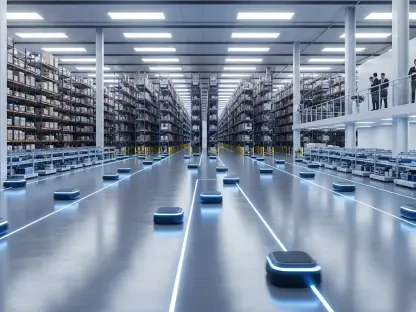In an era where intelligentization is reshaping the global business landscape, enterprises across industries are racing to adopt artificial intelligence (AI) as a cornerstone of their strategies, yet only a select few manage to turn this technology into a true competitive advantage. While many companies remain fixated on the race for more advanced model parameters or cutting-edge algorithms, the real challenge lies in translating AI into actionable outcomes within real-world business environments. The critical question is how to bridge the gap between technological innovation and measurable commercial value. At a major industry event, Huawei Connect, Chen Lei, Senior Vice President and President of Enterprise Sales at Huawei, unveiled the company’s insights and practical approaches to intelligent transformation. By sharing its experiences and collaborating with partners to launch nine tailored solutions for sectors such as government, education, healthcare, finance, and manufacturing, Huawei is paving the way for enterprises to navigate their unique paths to intelligent upgrading. This initiative underscores a commitment to not just adopting AI, but ensuring it delivers tangible impact across diverse industries.
1. Unpacking the Challenges of Intelligent Transformation
The journey to intelligent transformation is fraught with obstacles, even as the adoption of AI becomes increasingly widespread among enterprises. Market research from Gartner predicts that by 2027, 80% of Chinese companies will deploy local multi-model AGI, and by 2029, 60% will embed AI into their production systems, products, and services, positioning it as a primary driver of revenue growth. However, the availability of advanced technology does not automatically translate into business success. A significant divide persists between the supply of AI tools and the realization of business value, creating a core challenge for companies striving to integrate intelligence into their operations. This gap highlights the need for a strategic approach that prioritizes practical implementation over mere technological acquisition, ensuring that AI serves as a catalyst for meaningful change rather than a superficial addition.
Huawei, drawing from extensive experience alongside its partners, has identified five pivotal findings that shape the landscape of intelligent transformation. First, selecting the right scenarios is paramount—AI delivers maximum value when deeply integrated into core production processes, reshaping workflows and enabling smarter products and services. Second, the quality of vertical domain data is a determining factor in the effectiveness of industry-specific models, as generic solutions often fall short without customization. Third, the rapid expansion of AI agents fuels a growing demand for large-scale inference capabilities. Fourth, human-machine collaboration is emerging as a transformative organizational model. Finally, systematic governance and risk management remain essential to ensure AI applications are safe, sustainable, and trustworthy. These insights emphasize that successful transformation hinges on aligning technology with business needs and industry realities.
2. Defining a Strategic Roadmap for AI Integration
To address the complexities of intelligent transformation, Huawei has outlined a structured three-step approach designed to convert AI from a conceptual innovation into a driver of business value. The first step focuses on identifying high-impact scenarios, where enterprises must evaluate and prioritize business areas with the greatest potential for AI-driven improvement. This ensures that technology investments are directed toward processes that can yield significant returns, rather than being spread thinly across less critical areas. By concentrating on scenarios that align with core operational goals, companies can maximize the transformative potential of AI, reshaping workflows and enhancing service delivery in meaningful ways.
The second step involves calibrating AI models with vertical industry data to ensure relevance and effectiveness. Generic models, while powerful, often lack the specificity needed to address unique industry challenges. By leveraging high-quality, sector-specific data, enterprises can fine-tune these models to create tailored solutions that drive competitive differentiation. The third and final step is the large-scale deployment of AI agents to overhaul key business operations. This widespread implementation allows companies to embed intelligence across their value chains, fundamentally altering how they operate and compete. Together, these steps form a systematic framework that guides enterprises through the intricacies of AI adoption, ensuring that technology serves as a true enabler of growth.
3. Building the Infrastructure for AI Success
A robust ICT infrastructure is indispensable for supporting the diverse and complex needs of AI-driven transformation across industries. This foundation must encompass the entire lifecycle of AI implementation, from data preparation and transmission to model training, inference, and development. Huawei stands out in this arena by offering comprehensive tools such as the ModelArts platform for AI development and the DataArts solution for data governance and integration. These resources empower enterprises to transform raw data into actionable knowledge and, ultimately, into specialized models that address specific business challenges. Such an infrastructure ensures that AI initiatives are not only feasible but also scalable, providing the backbone for sustained innovation in dynamic market environments.
Real-world applications of Huawei’s capabilities further illustrate the impact of a solid infrastructure. In the power sector, collaboration with China Southern Power Grid led to the development of “MegaWatt,” a pioneering large-scale model built on the Ascend computing platform and MindSpore AI framework. This solution processes 100 problem images per minute—ten times faster than traditional algorithms—and generates rapid response plans for grid anomalies. Similarly, in healthcare, RunDa Medical utilized the Ascend inference server to create an AI medical record system deployed at West China Hospital, producing records in just one second and significantly enhancing diagnostic efficiency. These examples demonstrate how a strong technological foundation can drive transformative outcomes across varied sectors, turning AI into a practical tool for operational excellence.
4. Establishing a Collaborative Ecosystem for Industry Intelligence
Huawei’s role as a leader in intelligent transformation is underpinned by its early adoption of digital practices and extensive application of AI within its own operations, spanning production, logistics, R&D, and marketing. This hands-on experience has equipped the company with not only cutting-edge technology but also deep industry know-how. As one of the few providers offering end-to-end solutions—from underlying computing power to industry-specific applications—Huawei delivers integrated products like AI storage, high-speed data center networks, and the Ascend 384 super-node cluster. This full-stack approach minimizes the complexity and uncertainty of system integration, providing enterprises with a reliable and high-performance foundation for their AI initiatives, tailored to meet the demands of modern business landscapes.
Equally critical to this success is Huawei’s expansive partner ecosystem, which amplifies its ability to deliver customized solutions. With over 6,300 Kunpeng partners, 2,700 Ascend partners, 70 industry consulting firms, and 750 independent software vendors, the ecosystem leverages partners’ deep understanding of specific industry processes, pain points, and compliance needs. These collaborators act as the vital link between general AI technologies and practical business applications, ensuring solutions are finely tuned to real-world challenges. This model of collaboration fosters a cycle of growth, where industry feedback enhances technological capabilities, which in turn strengthens the ecosystem, creating a virtuous loop of innovation that benefits all stakeholders involved in the transformation journey.
5. Cultivating Long-Term Value Through AI Innovation
Reflecting on the strides made in intelligent transformation, it has become evident that AI has evolved beyond a mere enhancement tool into a fundamental engine for business growth, permeating every aspect of the value chain from research and development to production and service delivery. Huawei’s efforts over time have demonstrated a commitment to not just deploying technology, but embedding it in ways that redefine operational paradigms across industries. The focus on identifying the right scenarios and fortifying data foundations has ensured that AI applications deliver maximum impact, driving efficiency and innovation in sectors as diverse as energy and healthcare, where tailored solutions address long-standing challenges with remarkable results.
Looking ahead, the emphasis shifts toward sustaining this momentum by fostering an environment where intelligent innovation can flourish. Huawei positions itself as the fertile ground for industry intelligence, using its technological prowess and open ecosystem to nurture a thriving network of partnerships. This approach sets a powerful precedent for the industry, prioritizing the long-term goal of benefiting society and promoting shared prosperity over short-term technological wins. Enterprises are encouraged to build on this foundation, leveraging collaborative models to adapt to evolving needs and continuously refine AI strategies. By focusing on co-creation and systemic integration, the industry can ensure that the wave of intelligentization becomes a lasting force for positive change.









